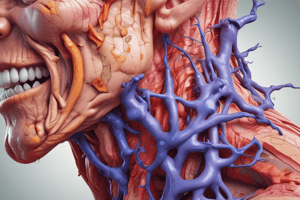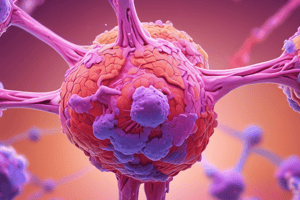Podcast
Questions and Answers
What was the previous name for systemic connective tissue diseases, which does not reflect their essence?
What was the previous name for systemic connective tissue diseases, which does not reflect their essence?
- Connective tissue diseases
- Rheumatic diseases
- Collagen diseases (correct)
- Immunological disorders
What is the primary cause of connective tissue damage in rheumatic diseases?
What is the primary cause of connective tissue damage in rheumatic diseases?
- Infection by virus
- Genetic mutations
- Physical factors such as cooling
- Immunological homeostasis disruption (correct)
How many phases are involved in the manifestation of connective tissue damage in rheumatic diseases?
How many phases are involved in the manifestation of connective tissue damage in rheumatic diseases?
- 6
- 5
- 3
- 4 (correct)
What is the primary feature that distinguishes one rheumatic disease from another?
What is the primary feature that distinguishes one rheumatic disease from another?
What is the common underlying mechanism of rheumatic diseases?
What is the common underlying mechanism of rheumatic diseases?
What is the typical course of rheumatic diseases?
What is the typical course of rheumatic diseases?
What type of cells typically surrounds rheumatic granulomas during development?
What type of cells typically surrounds rheumatic granulomas during development?
What is the final phase of connective tissue disorganization in rheumatism?
What is the final phase of connective tissue disorganization in rheumatism?
Which pathologist described the process of rheumatic nodule morphogenesis in more detail after Aschoff?
Which pathologist described the process of rheumatic nodule morphogenesis in more detail after Aschoff?
Which of the following is NOT a form of rheumatic valvular endocarditis?
Which of the following is NOT a form of rheumatic valvular endocarditis?
What type of endocarditis is characterized by fibrosis and scarring as a prominent feature?
What type of endocarditis is characterized by fibrosis and scarring as a prominent feature?
In rheumatic endocarditis, what is noted concerning the connective base of the endocardium?
In rheumatic endocarditis, what is noted concerning the connective base of the endocardium?
Which manifestations are characteristic of the acute warty type of rheumatic valvular endocarditis?
Which manifestations are characteristic of the acute warty type of rheumatic valvular endocarditis?
Which layer of the heart experiences pronounced dystrophic and inflammatory changes in rheumatism?
Which layer of the heart experiences pronounced dystrophic and inflammatory changes in rheumatism?
Which connective tissue disorganization phase mainly results from cell proliferation and granulomas in rheumatism?
Which connective tissue disorganization phase mainly results from cell proliferation and granulomas in rheumatism?
What are the most characteristic changes in rheumatism when it comes to the specific organs affected?
What are the most characteristic changes in rheumatism when it comes to the specific organs affected?
What is the primary lesion location in rheumatism?
What is the primary lesion location in rheumatism?
What type of bacteria is responsible for the development of rheumatism?
What type of bacteria is responsible for the development of rheumatism?
What is the result of the immune response to streptococcal antigens in rheumatism?
What is the result of the immune response to streptococcal antigens in rheumatism?
What is the characteristic arrangement of cells in a typical rheumatic granuloma?
What is the characteristic arrangement of cells in a typical rheumatic granuloma?
What is the final stage of granuloma development in rheumatism?
What is the final stage of granuloma development in rheumatism?
What is the role of macrophages in rheumatic granulomas?
What is the role of macrophages in rheumatic granulomas?
What is the duration of the granuloma development cycle in rheumatism?
What is the duration of the granuloma development cycle in rheumatism?
What is the result of the damage to connective tissue in rheumatism?
What is the result of the damage to connective tissue in rheumatism?
What is the characteristic feature of mucoid swelling in rheumatism?
What is the characteristic feature of mucoid swelling in rheumatism?
What are the dystrophic changes in nerve cells associated with in rheumatic vasculitis?
What are the dystrophic changes in nerve cells associated with in rheumatic vasculitis?
What is the most common clinical form of rheumatism in children?
What is the most common clinical form of rheumatism in children?
Which organ can develop autoimmunization in rheumatism?
Which organ can develop autoimmunization in rheumatism?
What is the most common complication associated with rheumatism?
What is the most common complication associated with rheumatism?
What can be a source of thromboembolism in rheumatism?
What can be a source of thromboembolism in rheumatism?
What can lead to decompensated heart disease in rheumatism patients?
What can lead to decompensated heart disease in rheumatism patients?
What is the primary characteristic of nodular productive (granulomatous) myocarditis?
What is the primary characteristic of nodular productive (granulomatous) myocarditis?
What is the most common location of rheumatic granulomas in nodular myocarditis?
What is the most common location of rheumatic granulomas in nodular myocarditis?
Which form of myocarditis is characterized by a slight focal infiltration of the myocardium by lymphocytes, histiocytes, and neutrophils?
Which form of myocarditis is characterized by a slight focal infiltration of the myocardium by lymphocytes, histiocytes, and neutrophils?
What is the primary characteristic of diffuse interstitial exudative myocarditis?
What is the primary characteristic of diffuse interstitial exudative myocarditis?
Which form of myocarditis is associated with severe cardiosclerosis and can quickly end in decompensation and death of the patient?
Which form of myocarditis is associated with severe cardiosclerosis and can quickly end in decompensation and death of the patient?
What is the primary characteristic of rheumatic vasculitis?
What is the primary characteristic of rheumatic vasculitis?
What is the primary characteristic of rheumatic endotheliosis?
What is the primary characteristic of rheumatic endotheliosis?
What is the primary characteristic of rheumatic polyarthritis?
What is the primary characteristic of rheumatic polyarthritis?
What is the primary characteristic of rheumatic nodules?
What is the primary characteristic of rheumatic nodules?
What is the primary characteristic of rheumatic nodules?
What is the primary characteristic of rheumatic nodules?
Flashcards are hidden until you start studying




